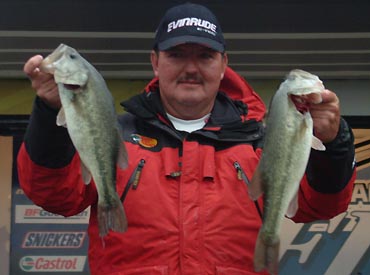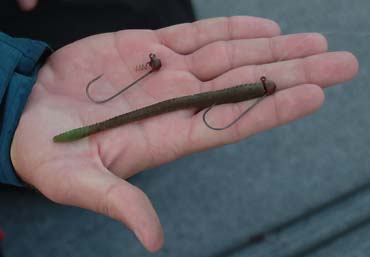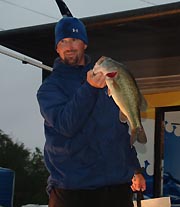Alabama’s Lewis Smith Lake is bass fishing’s equivalent of a U.S. Open golf course. Overgrown rough, narrowed fairways and rock-hard greens make it all but impossible for any golfer to break par for 4 straight days at an Open venue, and a dearth of 15-inchers make four consecutive limits at Smith just as unlikely.
Days 1 & 2
When Hoernke realized the forecast for rain on day 1 would prove correct, he hearkened back to the Bassmaster Tour event at Smith in 2004. Most of the top finishers focused on run-ins at the back of coves where new water was entering the lake.
He went as far as he could into the pockets and quickly learned that the largemouths were by then amenable to the power-fishing tactics that he prefers. He used a Lucky Craft Fat CB BDS Series 1 and his own Hoern Toad Tackle Brokeback Buzzer buzzbait to catch a four-fish, 9-06 bag that landed him in 9th place.
He thought he’d catch his best sack of the tournament on day 2, and he was right. Instead of a deluge, the precipitation was more of a drizzle, but the big key was that the sun remained absent.
He employed the same tactics as on day 1. The only differences were the pockets held more fish, and he switched to a fire/tiger-colored Lucky Craft BDS to accommodate the dirtier water. He caught 10 or 11 keepers en route to the 13-10 limit that put him in the lead to stay. His advantage would have been huge had he not lost a pair of 5-pounders.
Day 3
The return of the sun had Hoernke concerned about whether he could maintain his advantage, which was 2 1/2 pounds when day 3 dawned.
“The rain had stopped and the front had passed, and we had typical bluebird, post-frontal conditions,” he said. “I knew the run-in thing was over, and in order to win I’d have to do something different over the next 2 days.”
He tried to catch his largemouths with shakey-head worms, to no avail. “I moved around and pretty much cost myself the whole morning doing that. At about noon I said something’s got to give, and I started flipping a jig to laydowns or any form of shade.
“It was weird, but when it got colder, they wanted the jig. I couldn’t get bit on the worm. I went back through the same stretch and got four bites and caught two, and that salvaged the day.” His 4-12 bag kept him in the lead, but the margin was reduced to less than a pound and a half.
Photo: FLW Outdoors/Rob Newell
Sean Hoernke used his own Hoern Toad Tackle Porky’s Revenge jighead and a Zoom Finesse Worm to catch a limit on day 4. |
Day 4
Hoernke figured he needed to catch 10 pounds on day 4 to nail down the win, and doubted he could get it done with largemouths.
He pulled out the shakey-head gear he’d abandoned in practice and headed for the lower end of the lake.
Hoernke fished every piece of wood he could find in 5 to 20 feet of water.
He caught a keeper on his third cast of the day, then went about 4 hours without a bite. But things picked up when noon rolled around – he caught five or six keepers in a 45-minute span.
“I fished super-slow because I could just barely feel the bites. I actually lost several because I pulled it out of their mouth, the bite was so soft.”
The action shut down again before 1:00, but his work was done. He culled once in the final hour, but all that did was slightly boost his victory margin.
Winning Gear Notes
> Crankbait gear – 6’6″ medium-heavy Setyr CKN176MH rod, Shimano Chronarch casting reel (5:1 gear ratio), 15-pound P-Line copolymer, Lucky Craft Fat CB BDS Series 1 (root beer or fire/tiger).
> Buzzbait gear – 7′ medium-heavy Setyr CLS184MH rod, Shimano Chronarch reel (6:1 ratio), 20-pound P-Line copolymer, 1/4-ounce Hoern Toad Tackle Brokeback Buzzer (white with gold blade).
> Shakey-head gear – 7’2″ medium-heavy Setyr DSF184MH rod, Daiwa Carpricorn spinning reel, 8-pound P-Line Fluoroclear, 1/8oz Hoern Toad Tackle Porky’s Revenge jighead, 4-inch Zoom Finesse Worm (green-pumpkin).
> Flipping gear – 7’10” medium-heavy Setyr FNS194MH flipping stick, Shimano Castaic casting reel (6:1 ratio), 20-pound P-Line copolymer, 3/8oz Hoern Toad Tackle jig (black/blue), Zoom Super Chunk trailer (blue sapphire).
The Bottom Line
> Main factor in his success – “The key word was adaptation. I basically caught them three different ways over 4 days, and that seems to be the way Smith wants to be fished. There’s not a wad of them sitting anywhere to camp out on.”
> Performance edge – “On the last day it was my Porky’s Revenge jighead. It saved the day when things got tough.”
Deep or shallow. Spotted bass or largemouths. No matter an angler’s preference, crankbaits and jigs were the way to go for keeper bass at the Lewis Smith FLW Series in Alabama.
2nd: Jeff Shelton
Local firefighter Jeff Shelton, who fished the first four Series events as a co-angler, created a real-life, local-boy-makes-good story with his runner-up finish. There was also a rags-to-riches aspect to it, considering he was in 101st place after storm-plagued day 1.
He had home-field advantage, and he used it. “What I basically did before the tournament started was write down a list of 115 holes where I’d caught 3-pound or bigger fish,” he said. “Some of them I’d already fished (in recent team tournaments), and I put a mark by those if I knew fish were there.
“That left 65 other holes I wanted to check, and I checked them all. Some had fish, but most didn’t. That narrowed it down to about 25 places.”
He caught weigh-in fish on several different jigs, and also on shakey-head worms. The vast majority came from depths of 10 to 20 feet.
His best locales all had one thing in common. They all had red clay.
> Jig gear: 7′ medium-heavy Bass Pro Shops Extreme rod, Quantum Energy casting reel (6.3:1 gear ratio), 15-pound P-Line CXX (moss green), 5/16 or 3/8oz homemade jig (pumpkin/green glitter), Zoom Fat Albert Twin-Tail (brown/green-pumpkin), Zoom Super Chunk (green-pumpkin) or Arkie Salty Crawlin’ Grub (watermelon red) trailer.
> Shakey-head gear: 6’6″ medium heavy BPS Extreme rod, same reel, 12-pound P-Line CXX, 1/4-ounce homemade jighead, 4″ Zoom Finesse Worm (green-pumpkin).
> Main factor in his success – “Sticking with my game plan. I was determined to fish a jig every day, and the majority of my fish came on the jig.”
> Performance edge — “My Lowrance X125. I caught some fish that were pivotal that I never would have caught if I hadn’t seen them on the graph.”
Photo: FLW Outdoors/Rob Newell
Gerald Swindle |
3rd: Gerald Swindle
Gerald Swindle, the Bassmaster Elite Series pro from nearby Warrior, was another local who stormed back with a vengeance after struggling on day 1.
“I started out trying to catch deep fish (in practice),” he said. “Then we had all that rain and I stayed deep the first day. I only caught one, and I had to go up on the bank to get that one.
“I threw that deep stuff out the window the second day and went to shallow power-fishing (with a crankbait, a spinnerbait and a jig). I found a couple of creeks that had shad in the back of them and I started to get dialed in.”
As the lake level continued to rise, he caught fish from shallower and shallower depths. “My last fish on the last day, I was sitting in 2 feet of water and caught it out of 10 inches on a Lucky Craft Gunfish 115. That place was bone-dry in practice. You could’ve walked up and kicked a soccer ball across it.”
> Crankbait gear: 7′ medium-heavy Quantum Cabo rod, Quantum PT Series casting reel (6.3:1 gear ratio), 15-pound Spiderwire G-String line, Lucky Craft BDS 3 (fire/tiger).
> The Cabo rod, designed for saltwater applications, features a light tip.
> Spinnerbait gear: 6’6″ medium-heavy Quantum PT Series rod, same reel and line, 1/2-ounce War Eagle spinnerbait (white/yellow with No. 3 Colorado and No. 4 Indiana blades).
> Jig gear: 7’4″ Quantum PT Series flipping stick, same reel, 20-pound G-String, 3/8oz Arkie jig (black/brown), Zoom Super Chunk trailer (green-pumpkin).
> The shallow topwater fish he caught on day 4 was enticed by a Lucky Craft Gunfish 115 (American Shad).
> Main factor in his success – “Throwing away what I did in practice and starting over. Also, I was able to keep moving with the fish – the more the water rose, the farther they moved in.”
> Performance edge – “The Lowrance 111. I would’ve never been able to find the shad without it.”

Photo: FLW Outdoors/Rob Newell
David Fritts |
4th: David Fritts
Crankbait guru David Fritts of North Carolina didn’t have a great practice, so he stuck with areas that were at least somewhat productive in the days leading up to the tournament.
He caught six keepers in 4 days of practice, but one was about 6 pounds, so that’s where heended up fishing. He alsovgot one good bite in another particular area, and out of those two places, Iis where he concentrated. He caught good bags on the odd-numbered tournament days (1 and 3), but struggled on days 2 and 4.
His fish were relating to points. Some were tight to brush and others were suspended over creek channels or small ditches.
> Crankbait gear: 7′ medium-heavy American Rodsmiths David Fritts Signature Series cranking rod, Bass Pro Shops casting reel (4.7:1 gear ratio), 10-pound Rapala cranking line, Rapala DT 6 crankbait.
> Main factor in his success – “I just relied on my knowledge of crankbaits – the right colors and right actions. When most of the fish are related to the bottom, everything has to be just right.”
> Performance edge – “Probably my 7-foot rod. I needed the extra length to make a really long cast and keep the bait down about a foot deeper than it normally runs.”
5th: Rusty Salewske
California’s Rusty Salewske also had a feast-or-famine tournament, but his trend ran opposite to Fritts’ – he caught his best bags on days 2 and 4. His day-2 stringer was the best of the tournament.
He targeted deep spotted bass the first 3 days, but switched up and caught a limit comprised entirely of largemouths on day 4. Whether he was shallow or deep, he had a jig tied to the end of his line. Run-ins at the backs of coves were the key to his final-day bag.
“The best ones had little mats that had formed out of pine needles and garbage and stuff,” he said. “(The fish) were right up tight against them. “I think I could’ve caught them with a frog, but I stayed with the jig because you can catch nine out of 10 bites. Those frogs are risky business.”
> Jig gear: 7′ medium-heavy G.Loomis 843 rod, Shimano Chronarch 100 casting reel (6.3:1 gear ratio), 14-pound Sunline fluorocarbon line, 3/8oz homemade football-head jig (green-pumpkin), Reaction Innovations Smallie Beaver trailer (green-pumpkin).
> Main factor in his success – “Being able to adjust on the last day. My downfall on the third day was not adjusting after I’d caught the 16-pound bag. I kept trying to make it happen again.”
> Performance edge – “My Lowrance26C HD. For finding brushpiles and stuff, it was crucial.”
Lewis Smith proved to be a tough nut to crack for most of the field, but these Pros were the best at catching 16″+ fish this past week.
Rich
RichLindgren.com
Rich’s Bassin’ Forum
Bass Fishing Tackle Blog
If you enjoy this Blog, consider making a PayPal donation to help me keep it going. No Donation too small, Thanks!



